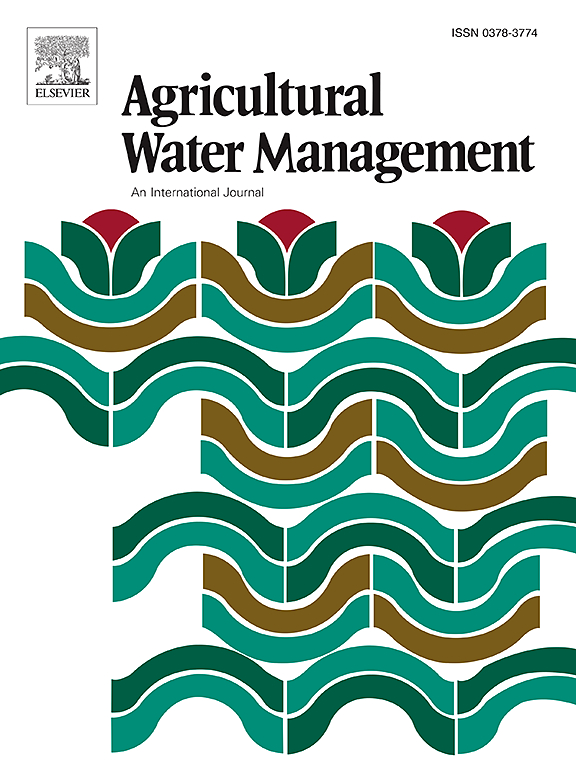Optimizing sowing date to mitigate loss of growing degree days and enhance crop water productivity of groundwater-irrigated spring maize
IF 5.9
1区 农林科学
Q1 AGRONOMY
引用次数: 0
Abstract
Groundwater irrigation (GWI) decreases soil temperature and increases crop growth duration and water consumption. Optimizing sowing dates offers a cost-effective solution to mitigate these effects. This study evaluated five sowing date treatments for spring maize: GWI on April 20 (GW420), April 25 (GW425), April 30 (GW430), May 5 (GW505), and May 10 (GW510), with surface water irrigation (SWI) on April 20 (SW420) as the control. The evaluated parameters included soil temperature at 5 cm depth (T5), soil-temperature-calculated growing degree days (GDDs), actual crop evapotranspiration (ETc-act), leaf area index (LAI), grain filling, grain yield, and crop water productivity (WPc). GW420 decreased daily maximum T5 by 1.8°C (P<0.05) and daily average GDDs accumulation by 5.9 % and increased the growth duration by 7.8 d and ETc-act by 33.2 mm compared to SW420. GW420 also delayed LAI growth and decreased the weight of maximum grain filling rate (Wmax) and maximum grain filling rate (Gmax), reducing mean LAI (LAIave) by 8.7 %, grain yield by 6.7 %, and WPc by 10.2 % (P<0.05). Late sowing compensated for GDDs loss in the GWI treatments, with the highest daily average GDDs accumulation observed in GW505 and GW510 (21.3°C d–1), followed by SW420 and GW430 (20.2–20.3°C d–1), and the lowest in GW420 and GW425 (19.1–19.4°C d–1). Late sowing also shortened growth duration and decreased ETc-act, with GW510 showing a 13.9 d shorter growth duration and GW425, GW430, GW505, and GW510 exhibiting 30.6, 36.0, 57.6, and 70.2 mm lower ETc-act, respectively, than GW420. Moderately late sowing (GW430) enhanced Gmax and maintained the active grain filling period (Tagp). Late sowing increased WPc by 7.9 %, 16.8 %, 17.4 %, and 17.2 % in GW425, GW430, GW505, and GW510 (P<0.05), respectively, compared to GW420. While the grain yields of GW430 and SW420 did not significantly differ, GW430 had a higher WPc than SW420, indicating that moderately late sowing fully compensated for the decline in grain yield and WPc of groundwater-irrigated maize. Entropy-TOPSIS analysis revealed that GW430 is the optimal sowing date for groundwater-irrigated maize in arid regions of northwest China, offering a cost-effective method to mitigate GWI-induced GDDs loss and enhance WPc.
优化播种日期,减少生长度日损失,提高地下水灌溉春玉米的作物水分生产率
地下水灌溉(GWI)会降低土壤温度,延长作物生长期并增加耗水量。优化播种期为减轻这些影响提供了一个具有成本效益的解决方案。本研究评估了春玉米的五个播种日期处理:地表水灌溉(SWI)在 4 月 20 日(GW420)、4 月 25 日(GW425)、4 月 30 日(GW430)、5 月 5 日(GW505)和 5 月 10 日(GW510)进行,地表水灌溉(SWI)在 4 月 20 日(SW420)作为对照。评估参数包括 5 厘米深的土壤温度(T5)、土壤温度计算的生长度日(GDDs)、作物实际蒸散量(ETc-act)、叶面积指数(LAI)、谷物灌浆、谷物产量和作物水分生产率(WPc)。与 SW420 相比,GW420 将日最高温度 T5 降低了 1.8°C (P<0.05),日平均 GDDs 累积量降低了 5.9%,生长期延长了 7.8 d,ETc-act 增加了 33.2 mm。GW420 还延迟了 LAI 的生长,降低了最大籽粒灌浆率(Wmax)和最大籽粒灌浆率(Gmax)的重量,使平均 LAI(LAIave)降低了 8.7%,籽粒产量降低了 6.7%,WPc 降低了 10.2%(P<0.05)。晚播弥补了 GWI 处理的 GDDs 损失,GW505 和 GW510 的日平均 GDDs 累积量最高(21.3°C d-1),其次是 SW420 和 GW430(20.2-20.3°C d-1),GW420 和 GW425 的最低(19.1-19.4°C d-1)。晚播也缩短了生长期并降低了 ETc-act,GW510 的生长期比 GW420 短 13.9 d,GW425、GW430、GW505 和 GW510 的 ETc-act 分别比 GW420 低 30.6、36.0、57.6 和 70.2 mm。适度晚播(GW430)提高了 Gmax,并保持了谷粒的有效灌浆期(Tagp)。与 GW420 相比,晚播 GW425、GW430、GW505 和 GW510 的 WPc 分别增加了 7.9 %、16.8 %、17.4 % 和 17.2 %(P<0.05)。虽然 GW430 和 SW420 的谷物产量没有显著差异,但 GW430 的 WPc 却高于 SW420,这表明适度晚播完全弥补了地下水灌溉玉米谷物产量和 WPc 的下降。熵-TOPSIS分析表明,GW430是中国西北干旱地区地下水灌溉玉米的最佳播种期,为减轻GWI引起的GDDs损失和提高WPc提供了一种经济有效的方法。
本文章由计算机程序翻译,如有差异,请以英文原文为准。
求助全文
约1分钟内获得全文
求助全文
来源期刊

Agricultural Water Management
农林科学-农艺学
CiteScore
12.10
自引率
14.90%
发文量
648
审稿时长
4.9 months
期刊介绍:
Agricultural Water Management publishes papers of international significance relating to the science, economics, and policy of agricultural water management. In all cases, manuscripts must address implications and provide insight regarding agricultural water management.
 求助内容:
求助内容: 应助结果提醒方式:
应助结果提醒方式:


